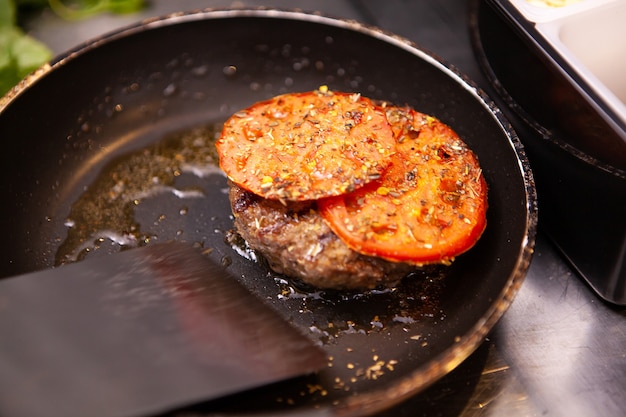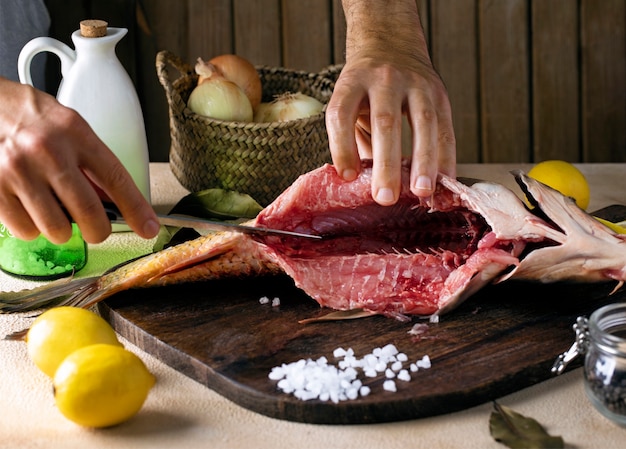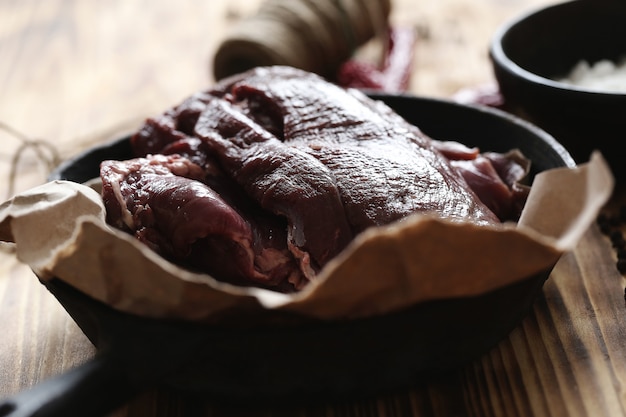Ah, steak. The mere mention of it conjures up images of sizzling, perfectly seared meat, juicy and tender, with a tantalizing aroma that fills the air. It’s a culinary masterpiece that can elevate any meal, from a casual weeknight dinner to a celebratory feast. And when it comes to cooking steak, there's no better tool than a trusty cast iron skillet. It's like a magic wand, transforming a simple cut of meat into something truly special.
Over the years, I’ve cooked my fair share of steaks, and I've learned a thing or two about achieving that perfect sear and juicy interior. It's not rocket science, but there are a few key techniques and tricks that can make all the difference. So, grab your favorite bottle of red, settle in, and let's get cooking!
(Part 1) choosing the right steak

The first step to a fantastic steak is choosing the right cut. It’s not just about picking a fancy name; you want a cut that's suited for the cooking method and your desired outcome. Each cut brings its unique flavor and texture, so choosing wisely is crucial.
Choosing the Cut: A Guide to steak cuts
There's a steak cut for every taste and occasion. Here’s a breakdown of some popular choices and their best uses:
- Ribeye: The king of steaks, known for its rich marbling and buttery, melt-in-your-mouth texture. Think of this as the ultimate indulgence. It's best cooked medium-rare to medium, allowing the fat to render and create incredible flavor.
- new york strip: A leaner option with a robust, meaty flavor and a nice, even texture. It holds up well to a good sear and is delicious cooked medium to medium-well.
- filet mignon: Super tender and decadent, but also quite lean, making it a bit more delicate to cook. It’s best cooked medium-rare to medium to maintain its tenderness.
- Sirloin: A fantastic all-around steak, affordable and flavorful, with a good balance of fat and lean. It works well cooked medium to medium-well.
- flank steak: A tougher and more flavorful cut, best suited for grilling or marinating. It’s best cooked medium-well to well-done, as its tough fibers benefit from a longer cooking time.
Thickness Matters:
Don't underestimate the importance of steak thickness. A good steak for cast iron cooking should be at least 1 inch thick. This allows for a perfect sear on the outside and a juicy, tender interior. Thinner cuts tend to overcook quickly and risk becoming dry and tough.
Marbling: The Secret to Flavor
Marbling, the streaks of fat running through the muscle, is the key to a juicy and flavorful steak. It's like the secret ingredient that adds richness and depth of flavor. Look for a steak with good marbling, particularly if you're going for a ribeye or other well-marbled cuts. You'll see white streaks running through the red muscle, a visual indication of its quality.
(Part 2) Preparing the Steak

Now that you've chosen your perfect steak, it's time to get it ready for its starring role. Proper preparation ensures even cooking and enhances the final flavor.
Temperature: A Crucial Step
Bringing your steak to room temperature is a vital step that many people overlook. Imagine throwing a cold steak into a hot pan. The outside will cook much faster than the inside, resulting in an uneven cook and a potentially tough steak. By bringing the steak to room temperature (around 68°F or 20°C), you ensure it cooks evenly, creating a more tender and juicy final product. Take your steak out of the refrigerator about 30 minutes before cooking, allowing it to gradually reach room temperature.
Seasoning: The Art of Flavor Enhancement
Seasoning is where you can truly transform your steak into a culinary masterpiece. Salt and pepper are the foundation, and you should be generous with them. Don’t be shy with the salt! It enhances the natural flavors of the steak and adds depth. As the salt draws moisture out of the meat, it helps to create a delicious crust during searing.
You can experiment with other seasonings if you like, but keep it simple. A sprinkle of garlic powder, onion powder, paprika, or dried herbs can add a lovely touch. Just avoid overdoing it, as you want the natural flavor of the steak to shine through.
(Part 3) Prepping the Cast Iron Skillet: The Key to a Perfect Sear

Your trusty cast iron skillet is the star of the show, the tool that will create that gorgeous sear we all crave. It's time to get your skillet ready for action.
Heat: The Foundation of a Perfect Sear
High heat is the key to a truly magnificent sear. You want your cast iron skillet to be scorching hot before you even think about placing your steak on it. The best way to achieve this is to heat it over medium-high heat for about 5-7 minutes. You should feel the intense heat radiating from the skillet, a sure sign that it's ready.
Oil: The Lubricant for a Delicious Crust
Once your skillet is screaming hot, add a generous amount of oil. I prefer using a neutral oil like grapeseed oil or avocado oil because they have a high smoke point and won't burn easily. But any oil will do; it's there to lubricate the pan and help the steak sear properly. You don't need a lot of oil, just enough to coat the bottom of the pan. Too much oil can create excessive smoke and make it harder to achieve a good sear.
(Part 4) Searing the Steak: Creating a Delicious Crust
Now comes the moment of truth! It's time to sear your steak, transforming it from a simple cut of meat into a culinary masterpiece. This is the most crucial part, so pay close attention.
Technique: Mastering the Art of Searing
Gently place the steak in the hot skillet, ensuring not to overcrowd the pan. Let it cook undisturbed for 2-3 minutes per side. This creates a beautiful, crispy crust, the hallmark of a perfectly seared steak. Resist the temptation to move it around or poke it with a fork. Let it sit there and do its thing, trusting that it's transforming into something delicious.
Searing Marks: More Than Just Beauty
As the steak sears, you'll see those beautiful grill marks forming. These marks aren't just for show; they're a sign that your steak is cooking evenly, a crucial step for a tender and juicy final product.
Flipping: Adding Flavor and Aromatics
After 2-3 minutes, flip the steak over and cook for another 2-3 minutes. Once it's flipped, you can add some aromatics to the pan for an extra flavor boost. Butter, garlic, and rosemary are excellent additions that infuse the steak with their delicious aromas and create a rich, flavorful sauce.
(Part 5) Checking the Doneness: Ensuring Perfection
Your steak is seared, but you need to ensure it's cooked to your desired level of doneness. It’s crucial to avoid undercooked or overcooked steak, so pay close attention to this step.
Methods: A Guide to Checking Doneness
There are several methods to check the doneness of your steak, each with its own advantages. You can use:
- A meat thermometer: This is the most accurate way to check doneness. Simply insert the thermometer into the thickest part of the steak, avoiding the bone. Different temperatures correspond to different levels of doneness.
- The Finger Test: This method is a bit more subjective, but it can be helpful if you don't have a thermometer. Press your finger against the fleshy part of your palm, and compare the feel to the feel of the steak. The texture will be similar at a certain doneness level.
Doneness Chart: A Guide to Temperatures
Here's a quick guide to the different levels of steak doneness and their corresponding temperatures:
| Doneness | Temperature (°F) | Temperature (°C) |
|---|---|---|
| Rare | 125-130 | 52-54 |
| Medium-Rare | 130-135 | 54-57 |
| Medium | 135-140 | 57-60 |
| Medium-Well | 140-145 | 60-63 |
| Well-Done | 145 | 63 |
(Part 6) Resting the Steak: The Key to Tenderness and Juiciness
Your steak is cooked to perfection, but you’re not quite ready to dig in just yet. It needs a well-deserved rest, a step that many people overlook but is crucial for ensuring a juicy and flavorful steak.
Why Resting Matters: Redistributing Juices
When you cook a steak, the juices become trapped inside. Resting the steak allows those juices to redistribute throughout the meat, resulting in a more tender and juicy steak. Think of it as a relaxation period for the steak, allowing it to recover from the heat and settle back into its perfect state.
How to Rest: A Simple Process
Simply transfer the steak to a cutting board and cover it loosely with foil. Let it rest for 5-10 minutes before slicing and serving. This allows the juices to redistribute and settle back into the steak. Patience is key here!
(Part 7) Serving and Enjoying: A Culinary Symphony
Your steak is rested, your table is set, and your taste buds are ready. It’s time to enjoy your culinary masterpiece!
Slicing: The Art of Presentation
Slice your steak against the grain, cutting perpendicular to the muscle fibers. This helps to make it more tender and easier to chew, enhancing the overall eating experience.
Sides: Complementary Flavors
Pair your steak with your favorite side dishes to create a symphony of flavors. Some classic pairings include creamy mashed potatoes, crisp asparagus, or roasted vegetables. Think about the flavors you want to complement your steak, whether it's a rich, creamy side or a fresh, vibrant one.
Sauce: Adding Depth and Richness
If you're in the mood for an extra layer of flavor, consider adding a sauce to your steak. A simple pan sauce made with the drippings from the steak is a classic option, capturing the essence of the cooking process. Or, try a store-bought sauce that complements the flavor profile of your chosen steak.
Wine Pairing: A Culinary Symphony
No steak is complete without a good glass of red wine to enhance the experience. Here are a few suggestions for pairing wine with your steak, balancing flavors and creating a delicious symphony:
- Ribeye: Cabernet Sauvignon, Zinfandel, or Merlot, with their rich and bold flavors, complement the robust, buttery flavor of a ribeye.
- New York Strip: Cabernet Sauvignon, Syrah, or Pinot Noir, with their earthy and complex notes, pair well with the meaty flavor of a New York Strip.
- Filet Mignon: Pinot Noir, Merlot, or Bordeaux, with their lighter and more delicate flavors, complement the tenderness and subtle flavor of a filet mignon.
- Sirloin: Cabernet Sauvignon, Merlot, or Zinfandel, with their full-bodied flavors, create a harmonious balance with the classic sirloin steak.
(Part 8) Cast Iron Skillet Maintenance: Caring for Your Culinary Workhorse
You’ve cooked your perfect steak, but it’s important to show your trusty cast iron skillet some love, ensuring it’s ready for your next culinary adventure.
Cleaning: The Gentle Approach
cast iron skillets are known for their durability, but they need a bit of TLC to maintain their seasoning and prevent rust. Avoid using soap, as it can strip away the protective seasoning layer. Instead, scrub the skillet with hot water and a stiff brush, removing any food residue.
Seasoning: Building a Protective Layer
After cleaning, you need to re-season your skillet to maintain its protective layer. Seasoning creates a nonstick surface that prevents rust and ensures consistent cooking. Simply wipe the skillet dry with a paper towel and rub a thin layer of oil over the surface. Place the skillet in a preheated oven at 350°F (175°C) for 30 minutes. Let it cool completely before storing.
FAQs
1. What are the best cuts of meat for cast iron steak?
I'd recommend a ribeye or New York Strip. They both cook beautifully in a cast iron skillet, creating a gorgeous sear and a juicy interior. However, if you're looking for something extra tender, a filet mignon is a fantastic choice. But ultimately, any cut of meat at least 1 inch thick will work, allowing for that perfect sear and juicy center.
2. How long should I cook a steak in a cast iron skillet?
The cooking time depends on the thickness of the steak and your desired level of doneness. A 1-inch thick steak should be cooked for about 2-3 minutes per side for a medium-rare doneness. For a medium steak, cook it for a bit longer, around 3-4 minutes per side. For a medium-well steak, you'll need to cook it for about 4-5 minutes per side. But, it's always best to use a meat thermometer to ensure it's cooked to your liking.
3. What happens if I overcrowd the pan?
If you overcrowd the pan, the steak won’t sear properly, and it might steam instead of searing. You won't get that beautiful, crispy crust. To ensure a perfect sear, cook the steak in batches if necessary, allowing each piece to have ample space in the pan.
4. What happens if I don’t let the steak rest?
If you don't let the steak rest, it will be tough and chewy. The juices won't have a chance to redistribute throughout the meat. Resting the steak allows those juices to settle back into the meat, resulting in a more tender and juicy steak.
5. What are some good side dishes to pair with steak?
The beauty of steak is that it pairs beautifully with a wide array of side dishes. I love to pair my steak with roasted vegetables, adding a burst of flavor and color to the plate. creamy mashed potatoes provide a comforting and satisfying accompaniment. A simple salad adds freshness and lightness. For a more indulgent option, try a creamy mushroom sauce or a decadent truffle risotto. The options are endless, allowing you to create a culinary experience that suits your taste and preferences.
Everyone is watching

Corn on the Cob: The Ultimate Guide to Perfectly Cooked Ears
Healthy MealsAh, corn on the cob. Just the name evokes images of sunny days, barbecues, and that sweet, juicy flavour that ...

Perfect Pork Roast Oven Cooking Time: A Guide to Delicious Results
Healthy MealsThere's something truly satisfying about a perfectly roasted pork. The aroma alone is enough to make your mout...

Ham Cooking Time: How Long to Bake, Smoke, or Boil a Delicious Ham
Healthy MealsAh, ham. It's a classic, isn't it? A real crowd-pleaser, especially around holidays. And when done right, it'...

Scallops: The Ultimate Guide to Perfect Cooking
Healthy MealsAh, scallops. Those delicate, sweet, and utterly delicious morsels of the sea. They hold a special place in my...

Spaghetti Squash: The Ultimate Guide to Cooking and Serving
Healthy MealsRemember that time you saw spaghetti squash at the supermarket, looking all bumpy and strange, and thought, "W...
